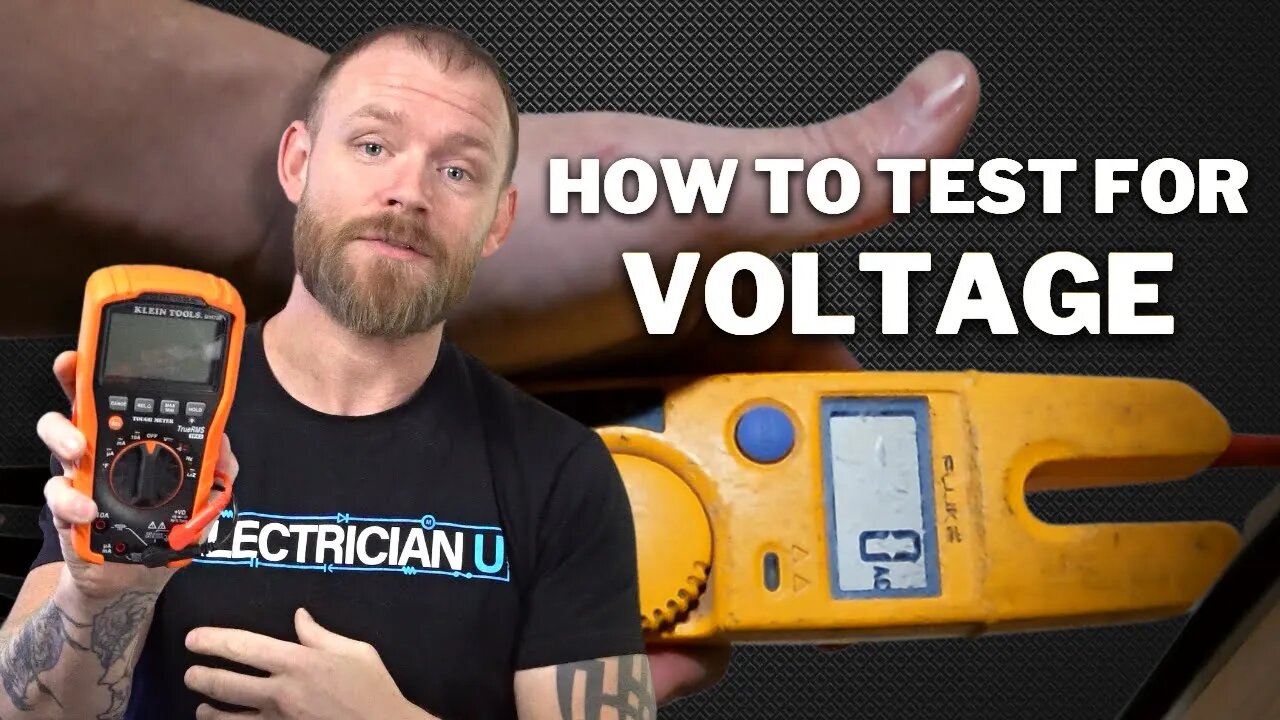Premium Only Content

How to Test for Voltage. What is Voltage? Can't You Just Use a Tick Tracer?
Join this channel to get access to perks:
https://www.youtube.com/channel/UCB3jUEyCLRbCw7QED0vnXYg/join
As electricians, we commonly use voltage to test circuits and to make things work in general. But what is it and how do we test for it? In todays episode of Electrician U, Dustin talks about what voltage is, how we can test for it, and what equipment we SHOULD/SHOULDN’T be using to test for it.
🤘⚡️MEMBERSHIP⚡️🤘
JOIN ELECTRICIAN U - become a member and get:
FREE Continuing Education every year
FREE Practice Exams
FREE Monthly Video Courses
FREE Weekly Live Instructor-Led Classes
FREE Monthly Educational Newsletter
Premium Members-Only Content
Private Discord Channel
Monthly Members-Only Discord Chats
Sign up here --- https://www.electricianu.com/electrician-u-membership/
🎧🎹MUSIC AND VIDEO:🎹🎧
https://www.facebook.com/descantmv
🎬✍️ART AND ILLUSTRATION:✍️🎬
https://www.daverussoart.com
A good analogy for voltage can be pressure. For instance, pressure in a water hose. The more pressure, the harder the water comes out. Same with an electrical circuit. Or a Slinky toy. If you were to pull it apart, the pressure waiting for that Slinky toy to snap back into place can be thought of as voltage.
Voltage in an electrical circuit is a difference in potential between 2 different points. In an electrical setting, once energized, we SHOULD have a voltage reading between certain things and we SHOULDN’T have voltage between other things. So, in a 120 type circuit, we SHOULD measure (nominally) 120v between hot and neutral and hot and ground. In a 3-phase environment, we should have a voltage reading between the HOTS AND a voltage reading between HOT and neutral and HOT and ground. We SHOULD NOT have any voltage readings between Neutral and Ground under any circumstances, as these two items are bonded together at the service point and are in essence on the same point. If you DO measure voltage between Neutral and Ground, something is off in the wiring between neutral/ground or there is a faulty piece of equipment somewhere in the system, which either requires some attention!
There are many pieces of testing equipment available to us electricians, and they all vary in what they can test for and how much you want to pay for them! A non-contact voltage tester (also commonly referred to as a tic tracer) is probably the most basic of the bunch. It glows and/or squeals at us when it is near a source of something energized. However, these types of test equipment are historically inaccurate and test via capacitance. You just have to get it close to the wire/buss/etc. It also can’t tell you how much voltage is present, only that it is. All this type of equipment will show you is if something IS energized only, and the circuit testing should be verified by a proper meter. A plug tester will also light up and show you that voltage is present, and will also tell you if you have wires backwards and a few other options. There are even new plug testers on the market that WILL tell you the voltage that is present. However, this type of testing equipment will only work on receptacles! Great if you are working on a receptacle, bad if you are attempting to test in a panel or J Box!
We should be using a multimeter to test for voltage. There are many options/manufacturers available. A meter should be of high quality (you are trusting your life with it after all!) and have the options that you will be using frequently. If there are any doubts as to what type of meter you should buy, talk to your veteran co workers and see what types they own/use.
To test for voltage, spin the dial to the appropriate setting (voltage) and put one lead on the neutral wire and one on a hot. If energized, the meter will display the voltage present. You should also be able to put a lead on the ground and one on the hot and get close to the same voltage as you did between hot and neutral. In a 3-phase environment, you can also test between 2 hots and get a reading, although it will be a higher number than a single hot.
We hope this has been an insightful look into HOW to test for voltage and some of the equipment used. Remember, when in doubt on what you should be reading on your meter, ask a veteran electrician! They are an invaluable source of information! Is there a topic you would like to see discussed on Electrician U? Leave a comment in the comments section and let us know. Please continue to follow Dustin and Electrician U as we are constantly updating our content to assist our followers in becoming the best electricians that they can be.
#electrician #electrical #electricity #how #to #test #for #voltage
-
 6:27
6:27
Electrician U
1 year ago💡 Watts vs Lumens: The New Lighting Standard You Need to Know! 💡
7.65K6 -
 LIVE
LIVE
LFA TV
12 hours agoLIVE & BREAKING NEWS! | WEDNESDAY 10/22/25
3,637 watching -
 LIVE
LIVE
Side Scrollers Podcast
2 days ago🔴FIRST EVER RUMBLE SUB-A-THON🔴DAY 3🔴100% REVENUE HELPS CHANGE CULTURE!
1,110 watching -
 8:58
8:58
Colion Noir
3 hours agoHe Installed a Forced Reset Trigger at a Gun Range… and Got Arrested | What You Need to Know
5.54K10 -
 LIVE
LIVE
Caleb Hammer
3 hours agoI (almost) Gave Up.. | Financial Audit
48 watching -
 LIVE
LIVE
The Big Mig™
2 hours agoEx CIA Director Brennan Indictment Inbound
164 watching -
 1:36:22
1:36:22
Graham Allen
2 hours agoDems Won’t Stop CALLING FOR VIOLENCE!! + Harry Sisson DESTROYED On LIVE TV!!
70K29 -
 LIVE
LIVE
Badlands Media
9 hours agoBadlands Daily: October 22, 2025
3,302 watching -
 LIVE
LIVE
Wendy Bell Radio
6 hours agoKing Of The Trolls
7,304 watching -
 14:00
14:00
It’s the Final Round
9 hours ago $0.11 earned💰NBA Best Bets🔥Player Prop Picks, Parlays, Predictions FREE Wednesday Today October 22nd 10/22
6.15K2